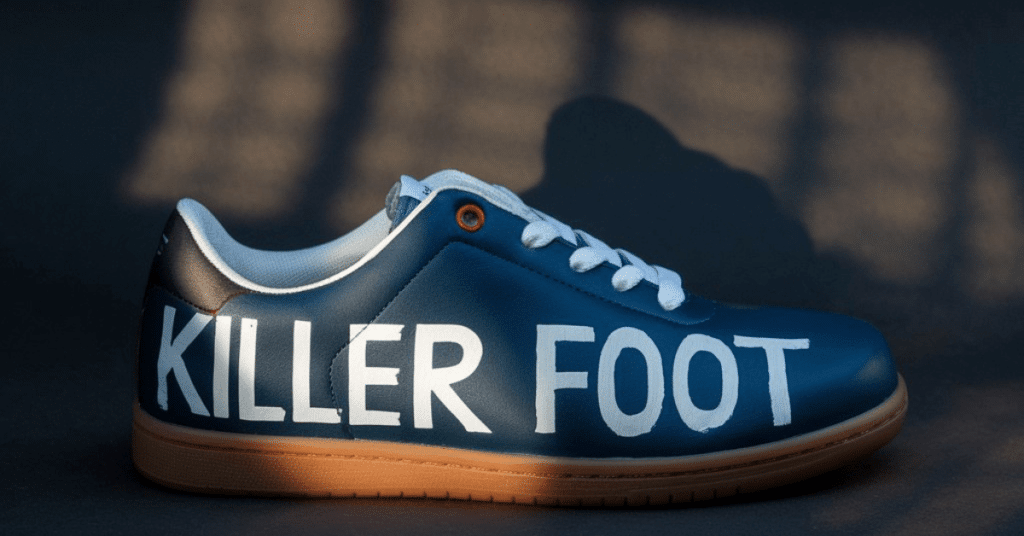Slew-foot or “slew-foot” refers to a condition in which a person’s feet naturally point outward when standing or walking. Instead of pointing straight ahead This condition, also known as out-toeing, can vary in severity and can affect children and adults, although it doesn’t always cause discomfort. But it can also affect posture, balance, and movement.
In this complete guide, We will discuss the causes, symptoms, and treatment of foot disease. We will also delve into the medical perspective. Exercises that can help and how to lead a healthy and active lifestyle. If you or someone you love has this symptom

What is a killer foot?
Foot toe refers specifically to gait in which a person’s toes point outward while walking or standing. This is often seen as an exaggerated “goat’s foot” attitude. It is the opposite of the toes, with the toes pointing inward. Outer toes are a common condition in children. And sometimes it can last into adulthood.
The thumb protrudes in children.
The outside of the toe is more common in infants and young children because the bones and muscles are still developing. In most cases, children outgrow this condition as they get older and develop better coordination and muscle control. But for some children, the outside of the toe may persist into adolescence or even into adulthood. This can cause discomfort or balance problems later in life…
The thumb protrudes in adults.
For adults, Foot abnormalities can be the result of genetic factors. Bad posture muscle asymmetry or other basic problems Although some people may adapt well and have no problems. However, some people may experience joint pain or mobility problems as they get older. Especially around the hips, knees, or ankles
Reason to be a slave
The causes of an outer thumb can vary depending on age, genetics, and environmental factors. Here are some common reasons:
Genetics
One of the main causes of foot killing is genetics. If a parent or a close family member has an outside toe, there is a chance that your children will suffer from the same situation. In these cases, toes are usually on the outside from birth and may continue into adulthood.
Regression of the femur
A position where the thigh bone (femur) is twisted back and the leg points outward. This condition is one of the most common structural causes of foot killing. Individuals with femoral head recession can develop hip and joint problems over time. If this problem is not resolved
Hip deformity
Hip dysplasia is a condition in which the hip joint does not fit properly. This can cause the toe to fall out in an individual. This is because misalignment affects the alignment of the hip joints and feet. Children with untreated hip deformity can grow up to have murderous foot movements.
Muscle Imbalance
muscle asymmetry Especially around the hips, knees, or lower back. The outside of the toes can be affected. When certain muscle groups are too tight or too weak The feet and legs rotate outward. This creates an exaggerated foot slave pose. Improper posture and inappropriate shoes can contribute to this.
Neurological status
In some rare cases, neurological disorders, such as cerebral palsy, can cause the outside of the toes to occur due to an inability to properly control foot movement. Such people may exhibit a lethargic gait as a result of muscle weakness or spasms.
Characteristics and effects of death blow
Although some people without the outside of their toes do not have symptoms, others may experience problems that affect their posture, balance, or movement.
Change your walking pattern.
One of the most noticeable features of Killer’s Foot is its altered gait pattern. The feet move outward. Makes you sway more while walking or placing weight unevenly on the soles of the feet
Joint pain
As time passes, People with toes on the outside will experience joint pain. This is especially true around the hips, knees, and ankles, as walking with your feet outputs more stress on the joints. This can lead to discomfort, inflammation, and even early arthritis.
Balance and coordination problems
The outside of the toe can affect balance and coordination. The outer foot position can make it difficult for a person to stand or walk on uneven surfaces. Some individuals also have difficulty with activities that require precise footwork, such as running or dancing.
Tiredness and muscle pain
The altered gait pattern associated with the outside of the toes was better achieved by those with a neutral gait. As a result, individuals with normal feet may experience muscle pain or fatigue. Especially after walking or standing for a long time.
Treatment options for towing
Treatment for sticky toe depends on the severity of the condition. Discomfort or mobility problems. In many cases, treatment may not be necessary. Especially in children who have relapses. However, if symptoms appear, there are treatment methods as follows:
Physical therapy
Physical therapy can effectively treat the outside of the toe. This is especially true if the muscles are unbalanced or tight, causing this condition. A physical therapist can design a variety of stretches and exercises. To strengthen the muscles in the hips, legs, and lower back. Helps keep your feet in the correct alignment…
Orthotic inserts
Custom orthotic inserts can provide additional support to the foot and help correct alignment issues. This information can help distribute weight more evenly across the foot. Helps reduce stress on joints and muscles.
Fix shoes
Wearing the right shoes can make a big difference in managing your toes outdoors. Supportive shoes with the right arch and heel can help align your feet better. And reduce pain or discomfort.
Surgery
Surgery may be recommended in severe cases where there is a structural abnormality outside of the toe (such as thigh recession or hip deformity). Surgery can correct bone alignment and improve movement. However, it is often considered a last resort when other treatments are ineffective.

Exercises to improve foot kill
In many cases, specific exercises can help reduce symptoms of the killer foot by addressing muscle imbalances and promoting good posture. Here are some exercises to consider.
Stretch the hip muscles.
Tight hip flexors can affect the outside of your toes. Stretching these muscles regularly can help improve alignment and reduce outward rotation.
Glue reinforcement exercises
Strengthening the glutes can help stabilize the hips and promote a more neutral foot position. Exercises such as squats, lunges, and leg raises can be effective for this purpose.
Balance training
Balance exercises, such as using a balance board while standing on one foot, can improve coordination and help retrain muscles to support better foot alignment.
Walking training
Practicing walking with your feet consciously pointed forward can help train your brain and muscles to adapt to a more neutral gait over time.
Living with being killed: Daily adjustments
For those with strong feet Modifying your daily activities can help reduce discomfort and improve your mobility, whether walking or standing for long periods. Exercise Small changes in posture and footwear can make a significant difference in how your body feels.
Choosing the right shoes
One of the most important considerations for people with outer toes is choosing the right shoes. Shoes that provide adequate arch support, cushioning, and strong heel support can help align your feet and promote good posture. It is recommended to wear shoes with a wide-toe box. This will give your feet more room to stretch out naturally. And reduce pressure on joints…
Avoid excessive stress.
People with outside toes may overwork their leg and hip muscles due to altered walking patterns. It is vital to avoid activities that put unnecessary stress on the joints, such as high-impact exercises such as running on hard surfaces. And low-impact exercise, such as swimming or cycling instead, is a great way to stay active without additional stress on the body.
Gesture recognition
Postural considerations play an important role in the management of cases of killed foot. Standing upright with your spine aligned and focusing on your core muscles can help you distribute your weight evenly across your legs. Simple posture adjustments will make your daily activities more comfortable. And reduce wear and tear on joints in the long term.

FAQs
Is being a foot killer hereditary?
Yes, in many cases foot loss is hereditary. If parents or close family members have outside toes, their children are more likely to have them as well.
Can foot killing cause health problems?
Although killing feet is not a problem for everyone, some people may experience joint pain. Balance problems or muscle fatigue resulting from altered gait.
Will my child grow up to be murdered?
Many children grow out of using their toes outdoors as they develop stronger muscles and better coordination. However, if symptoms persist into adolescence or adulthood, treatment may be required.
Conclusion
Being slew-footed, or out-toeing, is a condition that affects the way a person stands and walks, with the feet naturally pointing outward. While it is often harmless and common in children, some individuals may experience discomfort, joint pain, or balance issues later in life. Fortunately, there are various treatment options, including physical therapy, corrective footwear, and exercises that can help alleviate symptoms.
By understanding the causes, symptoms, and treatments associated with being slew-footed, you can take proactive steps to improve posture, reduce discomfort, and live a healthy, active lifestyle.

